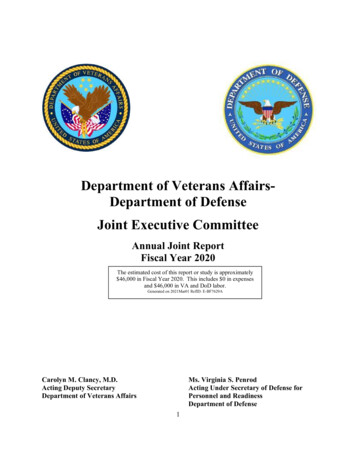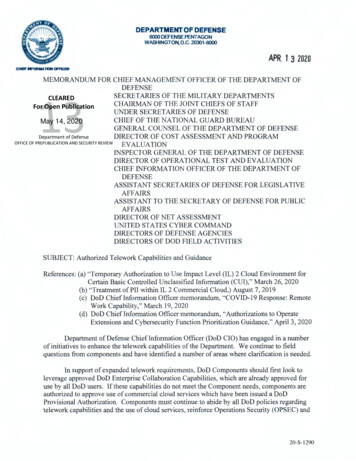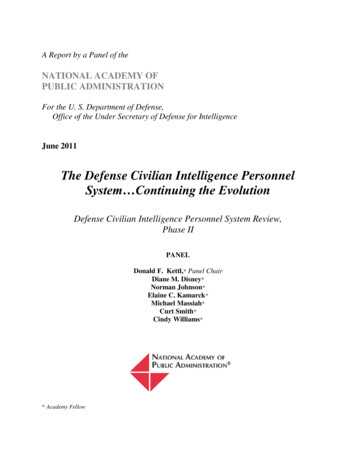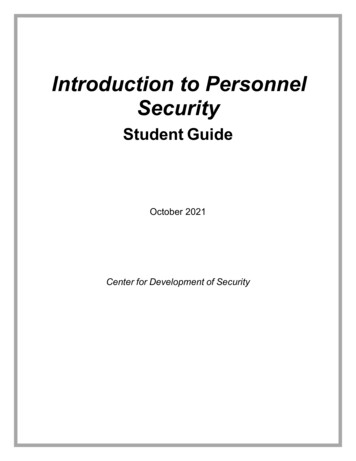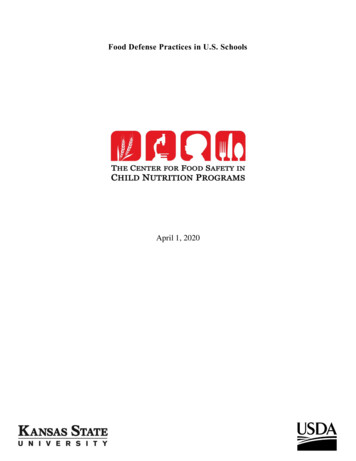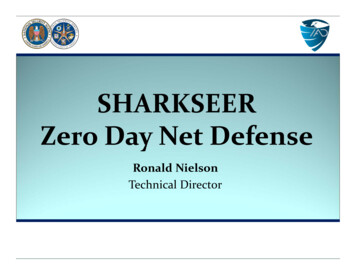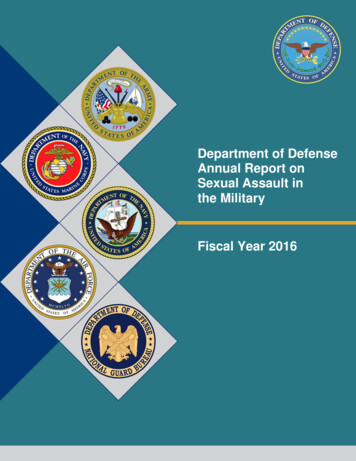
Transcription
Department of DefenseAnnual Report onSexual Assault inthe MilitaryFiscal Year 2016
Department of DefenseAnnual Report on Sexual Assault in the MilitaryFiscal Year 2016The estimated cost of report or study forthe Department of Defense isapproximately 4,479,000 in Fiscal Years2016-2017. This includes 3,336,000 in expensesand 1,143,000 in DoD labor.Generated on 2017Apr061RefID: 3-1495B24DoD SAPRO
Table of ContentsList of Appendices. 4List of Enclosures. 5Executive Summary . 6Fiscal Year 2016 Program Efforts . 6Advancing Sexual Assault Prevention . 6Assuring a Quality Response to Service Members Who Report Sexual Assault . 7Improving Response to Male Service Members Who Report Sexual Assault . 7Combatting Retaliation Associated with Sexual Assault Reporting . 8Fiscal Year 2016 Top Line Results . 8Reporting Behaviors . 8Prevalence . 9Introduction .10Spotlight: FY16 Data .12Advancing Sexual Assault Prevention .13FY16 Assessment of Progress .13Sexual Assault Rates for Men and Women Decreased Significantly Since 2014 .132016 Sexual Assault Estimated Prevalence Rate is at a Ten Year Low.13Risk of Sexual Assault on Military Installations Decreased Since 2006 .14Proportion of Sexual Assaults Committed by Civilians Increased Since 2006.14Multiple Alleged Offenders Risk About the Same for Men and Women .14Alcohol Involvement Increased .15LGBT Active Duty Members at Greater Risk for Sexual Assault and Sexual Harassment .15Sexual Assault Risk Remains Highly Correlated with Sexual Harassment Experience .16FY16 Actions to Advance Sexual Assault Prevention .16Conducted First Phase of the Installation Prevention Project .16Launched the DoD Prevention Collaboration Forum .17Initiated Development of the 2017-2021 Sexual Assault Prevention Plan of Action .17Continued Bystander Intervention Training .17Way Forward on Prevention in FY17 .18Continue Development of the 2017-2021 Sexual Assault PPoA .18Assuring a Quality Response to Service Members Who Report Sexual Assault.19FY16 Assessment of Progress .19Sexual Assault Reporting Continues to Increase .19Recent Rates of Restricted Report Conversions Remain Relatively High .192Fiscal Year 2016
Restricted Reports Converting More Quickly .20The Restricted Reporting Option Promotes Overall Reporting by Service Members.20About Ten Percent of Those Reporting Seek Assistance with a Pre-Service History ofSexual Assault .20Most Response Services Rated Higher by Women Than Men .21Reasons for Not Reporting a Sexual Assault Stayed Fairly Stable: Denial, Stigma, andShame.21FY16 Actions to Promote a Quality Response .22Continued Professional Development for SARCs and SAPR VAs through D-SAACP .22Expanded the Outreach of the DoD Safe Helpline .23Worked to Streamline Access from the DoD to the Department of Veterans Affairs .23Assured Confidentiality for Service Members Making a Restricted Report in States withMandatory Crime Reporting Laws .24Consulted with Other Government Agencies to Promote Improved Sexual Assault andHarassment Prevention and Response .24Military Services Improved Response and Victim Treatment .24Captured Survivor Feedback .25Way Forward on Assuring a Quality Response in FY17 .25Develop an Evaluation Tool to Assess D-SAACP Initial Training Participants .25Enhance DoD Safe Helpline Services by Launching a Self-Guided Education Tool .25Improving Response to Male Service Members Who Report Sexual Assault .26FY16 Assessment of Progress .26The Number of Men Experiencing Sexual Assault Decreased Significantly This Year .26Decreases in Estimated Prevalence for Men Came from Fewer Sexual Contact Crimes .26Reports from Women Still Outnumber Men, but More Men Reported the Crime in 2016than Ever Before .26Male Victims Tend to Be a Little Older Than Female Victims .27Certain Demographic Differences Among Men Increase Risk of Sexual Assault .27More Men Characterize Their Sexual Assault as Hazing or Bullying, and Experience MoreMultiple Incidents than Women.27Men and Women Report Sexual Assault for Mostly the Same Reasons .28Men and Women Experience Sexual Assault Differently .28Men Indicated Less Satisfaction with Services and Support from Individuals .29FY16 Actions to Improve Response for Male Service Members .29Developed the DoD Men’s SAPR Plan .29Conducted DoD Safe HelpRoom Webinar on Support for Men who Experience SexualAssault .30Implemented Methods to Improve Response and Outreach to Male Service Members .303DoD SAPRO
Way Forward on Improving Response for Male Service Members in FY17 .31Implement the DoD Plan to Prevent and Respond to Sexual Assault of Military Men .31Launch the Male Peer-to-Peer Safe HelpRoom Series .31Combatting Retaliation Associated with Sexual Assault Reporting .32FY16 Assessment of Progress .32A Quarter of Service Members Who Indicated Experiencing a Sexual Assault and ReportedIt to DoD Met Survey Criteria for Professional Reprisal .32About 14 Percent of Service Members Who Indicated Experiencing a Sexual Assault andReported It to DoD Met Survey Criteria for Ostracism .33About 18 Percent of Service Members Who Indicated Experiencing a Sexual Assault andReported It to DoD Met Survey Criteria for Maltreatment.33Social Media Plays a Role in About a Third of Perceived Ostracism and/or MaltreatmentExperiences .33About 32 Percent of Service Members Who Indicated Experiencing a Sexual Assault andReported It to DoD Met Survey Criteria for Any Kind of Retaliation (Professional Reprisal,Ostracism, and/or Maltreatment) .33FY16 Retaliation Reporting Data .35FY16 Retaliation Prevention and Response Actions .36Published the DoD Retaliation Prevention and Response Strategy .36Established DoD IG Whistleblower Reprisal Directorate .36Messaged Ways to Report Allegations of Retaliation .37Way Forward on Retaliation Prevention and Response in FY17 .37Implement the DoD Retaliation Prevention and Response Strategy .37Summary .38List of AppendicesAppendix A: FY16 Line of Effort HighlightsAppendix B: Statistical Data on Sexual AssaultAppendix C: Metrics and Non-Metrics on Sexual AssaultAppendix D: FY16 Aggregate Data MatricesAppendix E: Implementation Status of Sections of NDAA for FY16 Pertaining to SAPRAppendix F: Status of Secretary of Defense InitiativesAppendix G: Safe Helpline DataAppendix H: Sexual Harassment DataAppendix I: Special Analysis on Social MediaAppendix J: Domestic Abuse Related Sexual Assault4Fiscal Year 2016
Appendix K: Acronym ListList of EnclosuresEnclosure 1: Department of the ArmyEnclosure 2: Department of the NavyEnclosure 3: Department of the Air ForceEnclosure 4: National Guard BureauList of AnnexesAnnex 1: 2016 Workplace and Gender Relations Survey of Active Duty Members ReportAnnex 2: 2016 Military Investigation and Justice Experience Survey Report5DoD SAPRO
Executive SummaryTheDepartment’sSexualAssaultPrevention and Response Program isprevention-focused with an uncompromisingcommitment to victim assistance. Sexualassault prevention and response policies andactions are evidence-based and data driven.The Department strives to continuouslyimprove the Sexual Assault Prevention andResponse Program through Service memberfeedback, collaboration with external programstakeholders, and inter-Service collaboration.The Department initially created theSexual Assault Prevention and ResponseProgram in 2005. However, many of the legalreforms and improvements to the programoccurred in years since 2012. Theseimprovements have come from theapplication of research findings to programtenets, initiatives directed by the Secretary ofDefense, and Congressional legislation, toinclude the most comprehensive reform of themilitary justice system in 50 years. This year’sreport shows evidence of significant progressin the Department’s efforts to prevent andrespond to sexual assault. Nonetheless, thereis still much more work to do to continuethese trends into the future.Section 1631 of the Ike Skelton NationalDefense Authorization Act for Fiscal Year2011 (Public Law 111-383) requires theDepartment to provide Congress with anannual report on sexual assaults involvingmembers of the Armed Forces. This reportsatisfies that requirement. In this report, DoDuses the term “sexual assault” to refer to arange of crimes, including rape, sexualassault, forcible sodomy, aggravated sexualcontact, abusive sexual contact, and attemptsto commit these offenses, as defined by theUniform Code of Military Justice (UCMJ).6Fiscal Year 2016 Program EffortsThe Department of Defense workedaggressively during fiscal year 2016 toaddress four key program efforts: Advancing Sexual Assault Prevention,Assuring a Quality Response to ServiceMembers Who Report Sexual Assault,Improving Response to Male ServiceMembers Who Report Sexual Assault,andCombatting Retaliation Associated withSexual Assault Reporting.These efforts align toward a commonend, which is to reduce, with the goal toeliminate, sexual assault from the military.The report also outlines the many actionsadvanced by the Department, MilitaryServices, and National Guard Bureau duringfiscal year 2016.Advancing Sexual Assault PreventionSexual assault prevention stops violencebefore it begins. The Department designs itsprevention efforts to decrease the occurrenceof sexual assault, empower safe interventionin risky situations, detect risk and protectivefactors within unit climates, and emphasizeleadership’s central role in advancingworkplaces that promote dignity and respect.The Department completed the followingmajor efforts to advance sexual assaultprevention in fiscal year 2016: Conducted the first phase of theInstallation Prevention Project, a studyintended to identify installation andcommunity risk factors for sexual assaultanddevelopassociatedactionsleadership can take to mitigate sexualviolence.Fiscal Year 2016
LaunchedtheDoDPreventionCollaboration Forum to serve as avenue to facilitate the related practices which couldhave an impact across the Department.Initiated development of the 2017-2021Sexual Assault Prevention Plan ofAction that places primary prevention asa core focus in developing tasks andinitiatives that seek to stop the crime ofsexual assault before it occurs. The planaims to achieve unity of effort andpurpose across the Department ofDefense. Assuring a Quality Response to ServiceMembers Who Report Sexual AssaultThe Department’s response system aimsto empower victims, facilitate recovery, andencourage crime reporting.1 The Departmentcompleted the following major efforts toensure a quality response to Servicemembers who report sexual assault in fiscalyear 2016: 1Continued professional developmentforsexualassaultresponsecoordinators and victim advocatesthrough the Department of DefenseSexual Assault Advocate CertificationProgram, which ensures that appropriatepersonnel are appointed, appropriatelytrained, and in possession of the requisitelevel of knowledge and expertise toprovide assistance throughout thereporting and recovery process.Expanded the outreach of theDepartment of Defense Safe Helplinethrough an increase in efforts andavailable services. The Safe Helplineprovides anonymous crisis interventionsupport and connects Service membersAs used in this report, the term “victim” includes allegedvictims and the use of the terms “subject,” “offender,” or“perpetrator” does not convey any presumption about the guiltor innocence of any individual, nor does the term “incident” or“report” substantiate an occurrence of a sexual assault.7to resources that may ultimately lead to avictim making a report of sexual assault.As such, the Safe Helpline can help tobuild confidence in the reporting processfor those reluctant to use militaryresources.Worked to streamline access from theDepartment of Defense to theDepartment of Veterans Affairs tosimplify access to treatment resourceswhen moving from Service member toVeteran status and to close thecommunicationsgapbetweenthedepartments.Assured confidentiality for Servicemembers making a Restricted Reportin states with mandatory crimereporting laws. Federal law now allowsService members to file a RestrictedReport in state jurisdictions that havemandatory reporting laws. These reportsare kept confidential unless reporting isnecessary to prevent or mitigate seriousand imminent threat to someone. Thisremoves a potential barrier to reporting,and Department policy now enablesService members who make a RestrictedReport at military treatment facilities toreceive the necessary care withoutnotifying state officials unless a seriousand imminent threat to someone exists.Improving Response to Male ServiceMembers Who Report Sexual AssaultSexual assault is a crime that affects bothmen and women in the military and maleService members who experience sexualassault are less likely to report the incident.The Department completed the followingmajor efforts in fiscal year 2016 to improveresponse to male Service members whoreported sexual assault: Developed the Department of DefensePlan to Prevent and Respond to SexualAssault of Military Men that articulatesthe Department’s unified commitment todeveloping a data-driven prevention andresponse system that is tailored to militaryDoD SAPRO
men and supported by leaders at alllevels.Conducted the Department of DefenseSafe HelpRoom Webinar to supportmen who experienced sexual assaultto enhance responders’ knowledge aboutmale survivors and highlight thecapabilities of the Department of DefenseSafe HelpRoom.Combatting Retaliation Associated withSexual Assault Reportingsexual assault. The 2016 Workplace andGender Relations Survey of Active DutyMembers, the 2016 Military Investigation andJustice Experience Survey, and otherresearch drives the identification of potentialmajor issues facing the Department’s SexualAssault Prevention and Response Program.The Department uses findings from surveys,focus groups, reports of sexual assault, andother sources to shape its strategic approachand drive future program efforts.Fiscal Year 2016 Top Line ResultsRetaliation associated with reporting acrime or other misconduct not only harms thelivesandcareersofvictims,bystanders/witnesses, and first responders,but also undermines military readiness andweakens the culture of dignity and respect.The Department completed the followingmajor efforts to combat retaliation associatedwith sexual assault reporting in fiscal year2016: Published the Department of DefenseRetaliation Prevention and ResponseStrategy that aligns Departmental effortsin combatting retaliation related to reportsof sexual assault and complaints ofsexual harassment.Established the Department of DefenseInspectorGeneralWhistleblowerReprisal Directorate to investigate allcomplaints of reprisal related to a reportof sexual assault.These program efforts are not inclusive ofevery aspect of the crime of sexual assault,nor does this report detail every action thatthe Department, Military Services, and theNational Guard Bureau are taking to preventand respond to this crime. Additional programhighlights can be found in Appendix A of thisreport. The Department continues to assessits programs and policies to ensure that it iseffectively addressing the needs of Servicemembers.The Department measures progress inthis area by a number of metrics,understanding that no one metric is fullyreflective of progress.Primarily, theDepartment strives to decrease the numberof Service members who experience a sexualassault (i.e., prevalence), while increasing theproportion of these Service members whochoose to come forward to report this crimeand receive restorative care (i.e., reportingbehaviors).Reporting BehaviorsThe Military Services received 6,172reports of sexual assault involving Servicemembers as either victims or subjects ofcriminal investigations throughout fiscal year2016, which represents a 1.5 percentincrease from the reports made in fiscal year2015. Of the 6,172 reports of sexual assault,5,350 involved Service member victims. Ofthose 5,350 Service member victims, 556Service members (about 10 percent) made areport for incidents that occurred beforeentering military service. The remainingreports involved 778 victims who were U.S.civilians or foreign nationals and 44 victimsfor whom status data were not available.The Department of Defense offersService members the opportunity to makeeither an Unrestricted or Restricted Report ofsexual assault. The Military Services receivedThe Department employed severalassessment efforts to learn more about theimpact of programs to prevent and respond to8Fiscal Year 2016
4,5912 Unrestricted Reports involving Servicemembers as either victims or subjects in2016. In addition, the Military Services initiallyreceived 1,995 Restricted Reports involvingService members as either victims orsubjects. Four hundred fourteen (21 percent)of the initial Restricted Reports laterconverted to Unrestricted Reports. These 414converted Restricted Reports are nowcounted in the 4,591 Unrestricted Reports. Ofthe initial Restricted Reports, 1,581 reportsremained Restricted.The Department takes appropriate actionin every case where it has jurisdiction and theevidence to do so. This year, the Departmenthad sufficient evidence to take some kind ofdisciplinary action in 64 percent of caseswithin DoD’s legal authority. Disciplinaryaction was not possible for the remaining 36percent of cases due to evidentiary or otherlegal factors, such as the victim declining toparticipate, insufficient evidence of an offenseto prosecute, or other reasons. Appendices Band C of this report detail sexual assault datafrom fiscal year 2016.PrevalenceThe Workplace and Gender RelationsSurvey for Active Duty Members wasconducted in fiscal year 2016 to captureestimates of past-year sexual assault andsexual harassment prevalence (occurrence).In fiscal year 2016, 4.3 percent of active dutywomen and 0.6 percent of active duty menindicated experiencing sexual assault in theyear prior to being surveyed. These ratesrepresent a statistically significant decreasefrom the rates of sexual assault measured inthe 2014 RAND Military Workplace Survey.Using these rates, the Department estimatesthat about 14,900i Service membersexperienced some kind of sexual assault in2016, down from about 20,300 in 2014.Additional results can be found in Annex 1 ofthis report.Overall, this year’s statistical data indicatethat the Department is making progresstoward its dual goals of reducing theoccurrenceofsexualassaultandencouraging greater reporting of the crime. Infact, this year’s data suggest that about onein three Service members are choosing toreport their sexual assault, up from the one infour estimated for 2014 and the one infourteen estimated ten years ago in 2006.The Department of Defense remainscommitted to advancing a military culturewhere sexist behaviors, sexual harassment,and sexual assault are not tolerated,condoned, or ignored. Military commandersunderstand that prevention of sexual assaultis synonymous with military readiness, andempower their people to take appropriateaction to protect each other. TheDepartment’s ultimate success relies onevery member of the military communityunderstanding his/her role and acting tocreate a safer and healthier climate within theUnited States Armed Forces.2The Department pulls and analyzes data from DSAID sixweeks after the end of the FY to allow sufficient time for datavalidation. During this six-week period, 21 additional RestrictedReports converted to Unrestricted. These 21 reports areincluded with the 414 reports that converted from Restricted toUnrestricted that DoD counts with FY16 numbers.9DoD SAPRO
IntroductionThe Department of Defense (DoD) FiscalYear (FY) 2016 Annual Report on SexualAssault in the Military satisfies the followingstatutory reporting requirements: Section 542 of Carl Levin and Howard P.“Buck”McKeonNationalDefenseAuthorization Act (NDAA) for FY 2015(Public Law (P.L.) 113-291);Section 575 of NDAA for FY 2013 (P.L.112-239); andSection 1631 of Ike Skelton NDAA forFY11 (P.L. 111-383).Section 481 of Title 10 of the UnitedStates Code (U.S.C.) also requires theDepartment to conduct the Workplace andGender Relations Survey of Active DutyMembers (WGRA) every 2 years. The Officeof People Analytics (OPA) conducts thesurvey using measures created for the 2014RAND Military Workplace Study (RMWS) toestimate past-year sexual assault and sexualharassment prevalence in the active force.Active duty members of the Military Servicescould complete the survey online or on paper.Survey questions asked respondents abouttheir experience of sexual assault, outcomesassociated with reporting an incident ofsexual assault, and gender-related MilitaryEqual Opportunity violations. Results of the2016 WGRA can be found in Annex 1 to thisreport.OPA also conducted an additional surveyin FY16, the 2016 Military Investigation andJustice Experience Survey (MIJES), toassess Service members’ experiences withthe investigative and military justiceprocesses. The survey assessed opinionsand self-reported experiences associatedwith making an Unrestricted report of sexualassault. The 2016 MIJES was a voluntaryand anonymous survey. Participants includedService members who filed an UnrestrictedReport of an alleged sexual assault by analleged military perpetrator whose case10reached final disposition at the time thesample was drawn in 2016. Results of the2016 MIJES show that Service memberscontinue to value the support provided bySpecial Victims’ Counsel (SVC)/Victims’Legal Counsel (VLC) attorneys, SexualAssault Response Coordinators (SARC), andSexual Assault Prevention and Response(SAPR) Victim Advocates (VA). Respondentsnoted continued challenges with support fromimmediate supervisors and with perceptionsof retaliation associated with their report.However, the 2016 MIJES was not weighted;therefore, results of the study are notgeneralizable to all Service member victimswhose case reached final disposition. Resultsof the 2016 MIJES can be found in Annex 2to this report.This is the Department’s 13th AnnualReport on sexual assault, and it coverssexual assault allegations made during FY16(October 1, 2015 through September 30,2016). Enclosed with this report aresupplementary reports from the Secretariesof the Military Departments, the Chief of theNational Guard Bureau (NGB), and OPA.The SAPR program addresses sexualassault reports by adults against adults,including sex offenses, as defined in Articles120 and 125 of the Uniform Code of MilitaryJustice (UCMJ), and Article 80, attempts tocommit these offenses. Sexual assaultsbetween spouses or intimate partners fallunder the purview of the Family AdvocacyProgram (FAP). Appendix J of this year'sreport contains preliminary data on sexualassaults between spouses and intimatepartners that were reported to FAP in FY16.Military research suggests that sexualassault and sexual harassment areinterrelated problems. The 2016 WGRAdemonstrated a clear relationship betweensexual harassment and sexual assault.However, the behaviors that constitute sexualFiscal Year 2016
harassment do not always rise to the level ofcriminal misconduct. Such behavior isnonetheless disruptive to those Servicemembers targeted by the harassment andundermines good order and discipline.Sexual harassment requires a differentresponse than the crime of sexual assault.Sexual harassment falls under the purviewof the Office of Diversity Management andEqual Opportunity (ODMEO). Appendix Hof this year’s report contains data on formaland informal sexual harassment complaintsthat were made to ODMEO in FY16.This year’s report outlines four key FY16program efforts where the Department tookaction to accomplish its mission to reduce,with the goal to eliminate, sexual assault fromthe military. These program efforts areadvancingsexualassaultprevention,11assuring a quality response to Servicemembers who report sexual assault,improving response to male Servicemembers who report sexual assault, andcombatting retaliation associated with sexualassault reporting. The following pagessummarize key efforts and do not detail everyaction the Department, Military Services, andNGB are taking.The program efforts described in thisreport highlight actions to sustain andenhance the DoD prevention and , and policy changes to combatsexual assault.DoD SAPRO
Spotlight: FY16 Data12Fiscal Year 2016
Advancing Sexual Assault PreventionSexual assault prevention stops sexualviolence before it begins. The Departmenttakes a public health approach to preventingsexual assault by emphasizing the health,safety; and well-being of the entire militarypopulation. DoD strives to provide themaximum benefit for the largest number ofpeople.Preventionalsorequiresunderstanding the factors that influencesexual violence. The Department uses amodified version of the Centers for DiseaseControl’s social-ecological model (SEM) tobetter understand the impact of violenceacross the entire organization and the effectof potential prevention strategies. The SEMmodel considers the complex interplaybetween individual, relationship, community,and societal factors. The DoD model uses thesame approach, and adds
1 DoD SAPRO Department of Defense Annual Report on Sexual Assault in the Military Fiscal Year 2016 The estimated cost of report or study for the Department of Defense is approximately 4,479,000 in Fiscal Years 2016-2017. This includes 3,336,000 in expenses and 1,143,000 in DoD labor. Generated on 2017Apr06 RefID: 3-1495B24
